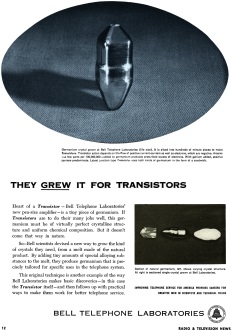|
GeAs (germanium and arsenic)
was the semiconductor substrate material of choice long before the III-V series
like GaN and GaAs came along. GeAs would be considered a III-IV semiconductor since
Ge is in group IV of the periodic
table (Ga is group III, As is group V). It is actually know simply as germanium.
1954, when this advertisement from Bell Telephone Laboratories appeared in Radio &
Television News magazine, was the same year that Texas Instruments (TI) introduced
the world's first commercially available
silicon (Si) transistor. The GeAs boule photo in the ad was printed
"life size," which makes it around 2" in diameter. Compare that to 12" diameter
wafers standard today for Si. Gallium nitride (GaN), a more exotic high frequency,
high temperature semiconductor compound, just recently grew (literally) beyond a
2" diameter boule size where it had been stuck for a decade. Individual device sizes
have decreased while wafer sizes have increased, so the number of devices per wafer
is way up and the cost per device is way down.
Bell Telephone Laboratories Ad
 Germanium crystal grown at Bell Telephone
Laboratories (life size). It is sliced into hundreds of minute pieces to make Transistors.
Transistor action depends on the flow of positive current-carriers as well as electrons,
which are negative. Arsenic - a few parts per 100,000,000 - added to germanium produces
prescribed excess of electrons. With gallium added, positive carriers predominate.
Latest junction type Transistor uses both kinds of germanium in the form of a sandwich. Germanium crystal grown at Bell Telephone
Laboratories (life size). It is sliced into hundreds of minute pieces to make Transistors.
Transistor action depends on the flow of positive current-carriers as well as electrons,
which are negative. Arsenic - a few parts per 100,000,000 - added to germanium produces
prescribed excess of electrons. With gallium added, positive carriers predominate.
Latest junction type Transistor uses both kinds of germanium in the form of a sandwich.
They Grew it for Transistors
Heart of a Transistor - Bell Telephone Laboratories' new pea-size amplifier -
is a tiny piece of germanium. If Transistors are to do their many jobs well, this
germanium must be of virtually perfect crystalline structure and uniform chemical
composition. But it doesn't come that way in nature.
So - Bell scientists devised a new way to grow the kind of crystals they need,
from a melt made of the natural product. By adding tiny amounts of special alloying
substances to the melt, they produce germanium that is precisely tailored for specific
uses in the telephone system.
This original technique is another example of the way Bell Laboratories makes
basic discoveries - in this case the Transistor itself - and then follows up with
practical ways to make them work for better telephone service.
Section of natural germanium, left, shows varying crystal structure. At right
is sectioned single crystal grown at Bell Laboratories.
Improving Telephone Service for America Provides Careers for Creative Men in
Scientific and Technical Fields
Bell Telephone Laboratories
Posted June 7, 2022
(updated from original post on 7/6/2015)
| Bell Telephone
Laboratories Infomercials |
-
The Future Holds Great Promise
- August 1949 Popular Science
-
Waveguide: 7/47 Popular Mechanics
-
Wire Wrapping - 10/1953 Popular Science
-
X-Rays, 4/60 Radio-electronics
- The Battle of
the Atoms, 4/1948 Radio News
-
The Transistor, 6/1952 Radio-Electronics
- 90-Mile Laboratory
for Telephone and Television, 6/1945 Radio News
-
Wire-Wrap, 10/53 Radio-Electronics
-
EDT Crystals, 10/47 Radio-Craft
- Germanium Refining,
5/54 Radio & TV News
- Crystal Timekeeping,
1/46 Radio News
- Transatlantic
Cable, 11/56 Radio & Television News
- Pipe Circuits,
11/48 Radio & Television News
-
Coaxial
Electron Tube, 6/54 Radio & Television News
- Thermocompression
Wire Bonding, 3/58 Radio News
-
Radio Relay Stations, 8/52 Radio & Television News
- Isolators,
6/56 Radio & Television News
- Punch
Cards, 3/55 Radio & Television News
-
Over-the-Horizon
Communications, 10/55 Radio & Television News
- Memory
Devices, 2/58 Radio & TV News
-
Adventure in Silicon, 5/55 Radio & Television News
- Pipes of Progress,
6/55 Radio & Television News
-
Project Echo, 11/60 Electronics World
|
-
Testing Phones - November 1947 Popular Science
-
Jacques Bernoulli, February 1960 Radio-Electronics
-
Type-O Carrier System, October 1952 Radio-Electronics
-
Electron Microscope, 4/1952 Radio-Electronics
-
Thermistor, 11/1946 Radio-Craft
-
Germanium Crystal, 1/1954 Radio-Electronics
-
Lens
Antenna, 5/46 Radio-Craft
- Quality Control, 6/46
Radio News Article
- Transcontinental
Radio-Relay, 10/51 Radio & TV News
- Solar
Battery, 7/54 Radio & Television News
-
Germanium Transistors, 1/54 Radio & Television News
- Cavity
Magnetron, 10/45 Radio News
-
The Cableman, 10/49 Radio & Television News
-
Coaxial Cable, 12/49 Radio & Television News
-
Tin
Whiskers, 12/55 Radio & Television News
- Relay
Contact Inspection, 7/55 Radio & Television News
- Transistor's
10th Anniversary, 6/58 Radio & Television News
-
Wire
Wrapping, 10/53 Radio & Television News
- Junction
Diode Amplifier, 11/58 Radio News
-
Nobel Prize Winners, 2/57 Radio & Television News
-
Diode Speeds Voices, 8/58 Popular Electronics
-
Microwave Relays, 7/59 Electronics World
|
|









